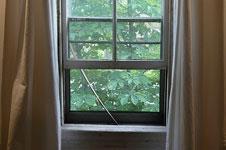Research finds that simple improvements to traditional 1880s windows can bring most up to modern standards
Research by English Heritage has shown that original sash windows can be as energy efficient as modern double-glazed windows.
Findings of a study into the thermal performance of a traditional sliding sash window dating from the 1880s showed that even the simplest repairs and basic improvements could bring significant reductions in draughts and heat loss, and that using a combination of these methods would upgrade most sash windows to meet Building Regulations.
Chris Wood, head of the building conservation and research team at English Heritage, who commissioned the research at Glasgow Caledonian University, said: “There is a lot of misunderstanding about the potential for historic buildings to be brought up to date. We hope this research will herald serious rethinking, and help homeowners and local authorities refurbish historic buildings with the confidence that modern standards can be met without compromising historic character - whether it is individual dwellings, a local school, town hall or public library. “
The key findings of the research include:
- Air infiltration through a sash window in good condition can be reduced by as much as 86% by adding draught proofing.
- Heat loss through contact with the glass and frames can be significantly reduced by adopting simple measures like closing thick curtains and plain roller blinds. In the test, heat loss was reduced by 41% and 38%, respectively.
- More elaborate measures reduce heat loss even more and can improve windows to meet modern building regulations, which target a U-value for windows of 2W/m²K or below. In a test with good quality secondary glazing, this value was brought down to 1.7W/m²K. Well-fitted, closed shutters, also produce similarly good results. The best result is when the two methods are used together, resulting in a 62% reduction in heat loss and a U-value of 1.6W/m²K.
Postscript
For details on the go to www.climatechangeandyourhome.org.uk



























